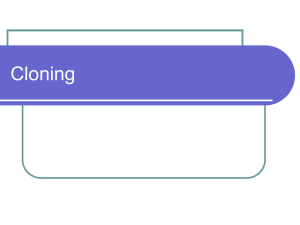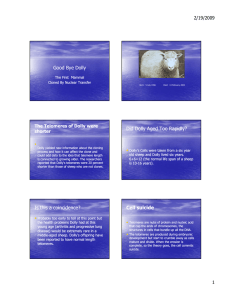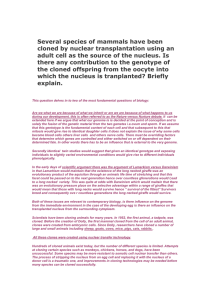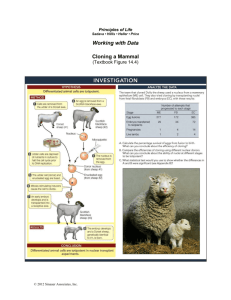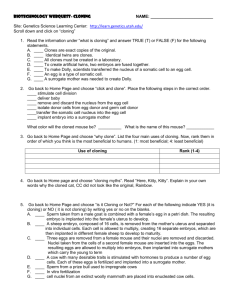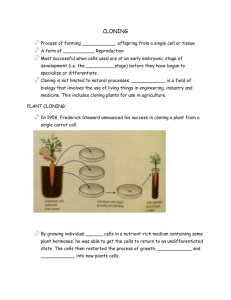Dolly Mixtures
advertisement
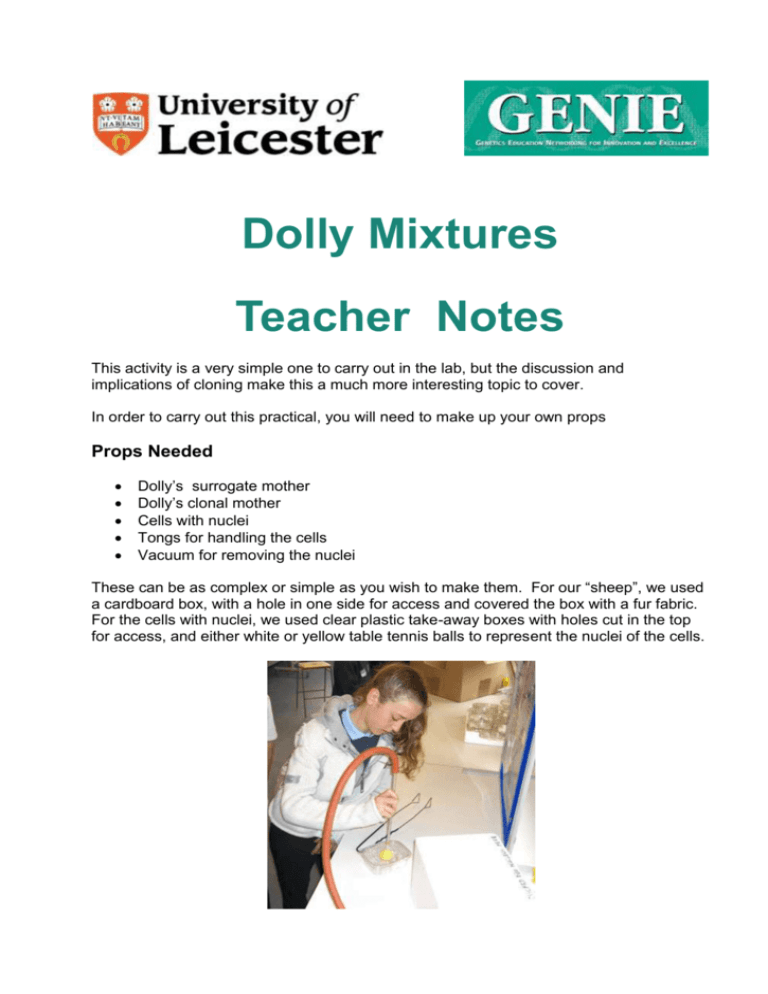
Dolly Mixtures Teacher Notes This activity is a very simple one to carry out in the lab, but the discussion and implications of cloning make this a much more interesting topic to cover. In order to carry out this practical, you will need to make up your own props Props Needed Dolly’s surrogate mother Dolly’s clonal mother Cells with nuclei Tongs for handling the cells Vacuum for removing the nuclei These can be as complex or simple as you wish to make them. For our “sheep”, we used a cardboard box, with a hole in one side for access and covered the box with a fur fabric. For the cells with nuclei, we used clear plastic take-away boxes with holes cut in the top for access, and either white or yellow table tennis balls to represent the nuclei of the cells. In order to make the exercise as realistic as possible, we used BBQ tongs for the students to use to handle the equipment in order to maintain “sterility”. The other item used was a plastic pipette which was connected to a water vacuum pump which students used to remove the nuclei. One possible supplier of these pumps can be found here: http://uk.vwr.com/app/catalog/Product?article_number=181-9100 In total you will need to make up two “sheep” – one for Dolly’s surrogate mother, and one for the clonal donor. Both of these “sheep” should contain a mixture of “cells” (clear plastic boxes with either yellow or white table tennis balls inside). White table tennis balls represent autosomal cell nuclei, yellow table tennis balls represent egg cell nuclei. Background Information Dolly the sheep was an ewe and was the first known successful clone of a mammal. She was cloned from an adult somatic cell using the process of nuclear transfer. She was born on July 5th 1996 and lived to be 6 years old. The cell used as the donor for the cloning of Dolly was taken from a mammary gland (hence the name “Dolly”), and the production of a healthy clone therefore proved that a cell taken from any part of the body could recreate a whole individual. The Activity Working in pairs, pupils aim to re-create Dolly for themselves. 1. With BBQ tongs (to maintain “sterility”) pupils remove an egg cell (egg cell nuclei are yellow) from Dolly’s surrogate mum. 2. They then have to remove the egg cell nucleus using the plastic pipette attached to the water vacuum and discard this nucleus properly in an appropriate “waste container”. They have now created an empty egg which contains no DNA. 3. They then take a body cell from Dolly’s clonal mum (body cells are stacked up as if they were in cell culture) and take the nucleus out of this cell and carefully place it into the nucleus-free egg cell which they have already created. 4. They have now made a “clone”! 5. Using the tongs they then have to place this egg into Dolly’s surrogate mum. 6. And if they are very lucky DOLLY is born! Things to Consider How would you test that Dolly is indeed a clone? The answer is that this was tested with DNA fingerprinting to see if Dolly’s DNA matched that of her clonal mother and not that of her surrogate mother. For more information on DNA fingerprinting: http://www.thenakedscientists.com/HTML/articles/article/dalyacolumn8.htm/ The cloning process is not actually as straightforward as this simple activity suggests, and it goes wrong a lot of the time. Cloning Dolly the sheep had a low success rate per fertilized egg; she was born after 277 eggs were used to create 29 embryos, which only produced three lambs at birth, only one of which lived. Virtual Genetics Education Centre: http://www.le.ac.uk/ge/genie/vgec/index.html Cloning in the future Although cloning may eventually become a viable tool for preserving endangered species and important in the future production of transgenic livestock, animal conservation professionals say that cloning does not solve the problems of loss of genetic diversity and loss of habitat. For this reason they see cloning more as an experimental technology for the time being, and would only rarely be worth the cost, which on a per-individual basis far exceeds conventional techniques such as captive breeding or embryo transfer. And what about the ethics of cloning? Already pets have been reproduced for wealthy pet lovers, but where will it stop? Is human cloning possible? Files provided with this activity: 1. Teacher notes.docx/rtf/pdf – this document 2. Student notes.docx/rtf/pdf – document for students to work from 3. Dolly Poster.gif/pdf – a poster showing the cloning process Virtual Genetics Education Centre: http://www.le.ac.uk/ge/genie/vgec/index.html

